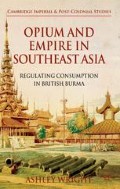Abstract
After the First World War, the government of India — and by extension the colonial administration in Burma — became part of a new transnational drug policy network. In the 1920s and 30s, Burma’s position in this network influenced the way that the British administration articulated its drug policy rationale. Burmese nationalists, as they became increasingly active against the colonial regime, condemned the effects that opium consumption had on the bodies of Burmese consumers, and drew upon the racially charged association of opium with the Chinese community in Burma to oppose both the colonial opium industry and the presence of “foreign” elements in Burma.
Access this chapter
Tax calculation will be finalised at checkout
Purchases are for personal use only
Preview
Unable to display preview. Download preview PDF.
Notes
Arguably the imposition of British rule in Burma after 1885 destabilised existing Burmese religious and political structures, creating favourable conditions for the spread of addiction. This explanatory model for the growth of addiction in a population comes from James E. Hawdon, Drug and Alcohol Consumption as Functions of Social Structures (Lewiston, New York: The Edwin Mellen Press, 2005).
See Sir Charles Crosthwaite, The Pacification of Burma (London: E. Arnold, 1912).
V.C. Scott O’Connor, The Silken East: A Record of Life and Travel in Burma (London: Hutchinson & Co., 1904), p. 741.
Thant Myint-U, The Making of Modern Burma (Cambridge: Cambridge University Press, 2001).
John F. Cady, A History of Modern Burma (Ithaca: Cornell University Press, 1958), p. 177.
Grattan Geary, Burma After the Conquest (London: Sampson Low, Marston, Searle, & Rivington, 1886), p. 115.
U Maung Maung, From Sangha to Laity (New Delhi: Manohar, 1980), p. xv. The British establishment was also aware of the significant Buddhist influence on Burmese nationalism: Grant Brown, a retired civil servant describing the Burmese nationalist movement in the mid nineteen twenties, attributed much of the nationalist organisation to the influence of the Buddhist monks R. Grant Brown, Burma as I Saw It: 1889–1917, with a Chapter on Recent Events (London: Methuen and Co., Ltd., 1926), p. 170.
V.C. Scott O’Connor, The Silken East: A Record of Life and Travel in Burma (London: Hutchinson & Co., 1904), pp. 84–5.
League of Nations — Conference on the Suppression of Opium Smoking — Minutes of the Meetings and Documents Submitted to the Conference (Geneva, 1932), p. 20.
While the distinction between the two methods of consuming the drug was in part culturally and historically based, there is medical evidence to support the idea that smoking opium is more addictive, or more quickly addictive, than eating opium. When a drug is inhaled, the blood containing the drug reaches the brain, undiluted, within three seconds, whereas the drug is absorbed by the stomach much more slowly. Avram Goldstein, Addiction: From Biology to Drug Policy (Oxford: Oxford University Press, 2001), p. 84.
League of Nations — Conference on the Suppression of Opium Smoking — Minutes of the Meetings and Documents Submitted to the Conference (Geneva, 1932), p. 22.
They were reopened between 1900 and 1903, as many Burmese addicts had not registered due to confusion about the registration instructions. League of Nations — Conference on the Suppression of Opium Smoking — Minutes of the Meetings and Documents Submitted to the Conference (Geneva, 1932), p. 19.
Ibid.
Author information
Authors and Affiliations
Copyright information
© 2014 Ashley Wright
About this chapter
Cite this chapter
Wright, A. (2014). Burma, the League of Nations and Transnational Opium Policy Networks. In: Opium and Empire in Southeast Asia. Cambridge Imperial and Post-Colonial Studies Series. Palgrave Macmillan, London. https://doi.org/10.1057/9781137317605_8
Download citation
DOI: https://doi.org/10.1057/9781137317605_8
Publisher Name: Palgrave Macmillan, London
Print ISBN: 978-1-349-33362-2
Online ISBN: 978-1-137-31760-5
eBook Packages: Palgrave History CollectionHistory (R0)

